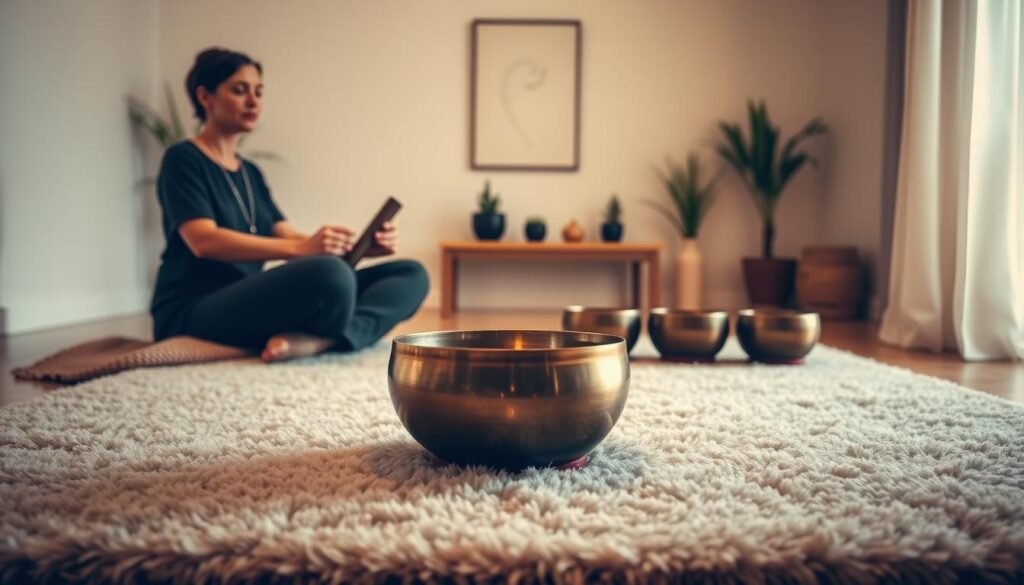
Can a simple, ancient meditation tool really change your emotional and spiritual health? The singing bowl, used for centuries, is known for its calming effects. It helps reduce stress and boosts overall well-being.
Adding singing bowl meditation to your daily routine can deeply impact your emotional and spiritual health. It calms the mind, soothes the body, and lifts the spirit.
Key Takeaways
- Reduce stress and anxiety with regular singing bowl meditation
- Enhance emotional well-being through the calming effects of sound healing
- Improve spiritual connection and inner peace
- Boost mood and overall sense of well-being
- Support a restful night’s sleep with pre-bedtime singing bowl practice
What is Singing Bowl Practice?
Singing bowls have been used for thousands of years in sound healing. They help people relax and reduce stress. The healing vibrations of singing bowls are thought to bring calm and inner peace.
The history of singing bowls is rich and varied. It spans across many cultures and continents. Let’s look at their origins, how they work, and types to see their role in sound therapy.
The History of Singing Bowls
Singing bowls come from the Himalayas. They were used in Buddhist and shamanic traditions for meditation and healing. The bowls were made from metals like bronze, copper, and tin, believed to have healing properties.
But singing bowls weren’t just used in the Himalayas. Ancient cultures like the Egyptians, Greeks, and Romans also used them. They used sound healing for relaxation and spiritual growth.
How Singing Bowls Work
Singing bowls make sound when hit with a mallet. This sound is believed to heal the body and mind. The power of sound therapy with singing bowls comes from their ability to produce healing frequencies.
- The vibrations from the bowl interact with the body’s energy fields, promoting balance and harmony.
- The sound helps quiet the mind, reducing stress and anxiety.
- The physical vibrations of the bowl can be felt when held against the body, providing a tangible sense of relaxation.
Different Types of Singing Bowls
There are many types of singing bowls, each with its own benefits. Some common types include:
- Tibetan Singing Bowls: Known for their deep tones, often used in meditation and healing.
- Crystal Singing Bowls: Made from quartz crystal, these bowls have a clear tone and are believed to have strong healing effects.
- Brass Singing Bowls: Made from a mix of metals, these bowls have a warm sound and are used in sound healing.
Understanding the history, mechanics, and types of singing bowls helps us appreciate their healing vibrations and power in sound therapy. They promote emotional and spiritual well-being.
Benefits of Daily Singing Bowl Practice
Adding singing bowl practice to your daily routine can greatly improve your well-being. It benefits both your mind and body, leading to calmness and relaxation.
Enhancing Emotional Stability
Singing bowl practice helps stabilize your emotions. It reduces turmoil and brings balance. The bowls’ soothing sounds calm your mind, helping you manage stress and anxiety better.
Key benefits include:
- Reduced emotional reactivity
- Increased sense of calm
- Improved emotional regulation

Boosting Spiritual Connection
Daily singing bowl practice enhances your spiritual connection. It brings inner peace and harmony. The bowls’ vibrations align your energy, fostering unity and connection to the universe.
The practice encourages:
- Deeper meditation
- Increased mindfulness
- A stronger sense of spiritual connection
Reducing Stress and Anxiety
Singing bowl practice is great for reducing stress and anxiety. The bowls’ calming tones slow your heart rate, lower blood pressure, and promote relaxation.
Tips for using singing bowls for stress relief:
- Practice regularly to experience consistent benefits
- Combine singing bowl practice with deep breathing exercises
- Use the bowls during meditation or yoga practice
By making singing bowl practice a part of your daily routine, you can enjoy these benefits. It will improve your overall well-being.
Setting Up Your Singing Bowl Space
A well-designed singing bowl space can greatly improve your mindfulness practice with singing bowls. Creating a special area for your practice helps deepen your meditation. It also boosts your overall well-being.
Choosing the Right Location
Finding the perfect spot for your singing bowl practice is key. Look for a quiet, peaceful place in your home. It should be somewhere you can sit comfortably without distractions.
Think about the natural light and air flow in the area. Good lighting and air can help you relax.
- Opt for a room with minimal external noise.
- Choose a spot with a calming view, if possible.
- Ensure the area is clutter-free to promote a sense of serenity.
Essential Accessories for Practice
To get the most out of your relaxation techniques using singing bowls, you need the right tools. Here are some must-haves:
- A high-quality singing bowl that resonates with you.
- A comfortable cushion or chair for seating.
- A mallet or striker designed for your singing bowl.
- Optional: candles, incense, or essential oils for ambiance.

Creating a Calm Atmosphere
To make your space calm, add elements that help you relax. Soft lighting can make the atmosphere more peaceful. Calming scents from essential oils or incense can also help.
Here are more tips for a serene space:
- Use calming colors for walls and decor.
- Add natural elements, like plants or a water feature.
- Turn off electronic distractions, like notifications.
Techniques for Effective Singing Bowl Practice
To get the most out of singing bowl practice, you need to learn a few key techniques. These techniques are not just for making soothing sounds. They help you connect deeper with yourself and improve your emotional and spiritual health.

Basic Playing Techniques
Learning how to play the bowl is the first step. Hold the bowl gently but firmly in your hand or on a cushion. Hold the mallet loosely and strike or circle it smoothly and steadily. Try different ways of striking and speeds to get different tones.
Breathing Exercises to Enhance Focus
Breathing exercises are key to improving focus during singing bowl practice. Deep, controlled breathing calms the mind and aligns your energy with the bowl’s vibrations. Inhale deeply through your nose and exhale slowly through your mouth, matching your breath with the bowl’s sound.
Incorporating Mindfulness
Mindfulness is a great addition to your singing bowl practice. As you play, pay attention to the mallet’s feel, the sound, and the vibrations. Mindfulness keeps you present and fully engaged in the healing process. It makes singing bowl therapy for stress relief even more effective, leading to relaxation and peace.
How to Incorporate Singing Bowls into Daily Routine
Adding singing bowls to your daily life can change your emotional and spiritual health. It brings calm and connects you to your inner self.

Morning Rituals with Singing Bowls
Starting your day with singing bowls sets a positive mood. Gently playing the bowl clears your mind and gets you ready for the day.
- Find a quiet spot in your home to sit comfortably.
- Play the singing bowl for a few minutes, focusing on the sound and your breath.
- Keep the calm feeling with you as you go about your morning.
Evening Relaxation Practices
Evening singing bowl use helps you unwind after a long day. The sounds calm your mind and body, readying you for sleep.
To enhance your relaxation practice, try these:
- Dim the lights and light candles.
- Play soft, calming music in the background.
- Do gentle stretches or yoga poses.
Spontaneous Moments of Mindfulness
Singing bowls are great for quick mindfulness moments during the day. When stressed or overwhelmed, take a few minutes to play your singing bowl and refocus.
| Benefits | Morning Practice | Evening Practice |
|---|---|---|
| Reduces Stress | Sets a positive tone for the day | Promotes relaxation before sleep |
| Enhances Mindfulness | Improves focus and clarity | Calms the mind and body |
| Spiritual Connection | Deepens sense of purpose | Fosters inner peace |
By adding singing bowls to your daily routine, you can enjoy these benefits. It leads to a more balanced and fulfilling life.
The Role of Intention in Practice
The power of sound therapy with singing bowls grows when done with clear intention. Intention guides the healing energy of the singing bowls towards your personal goals or emotional needs.
Adding intention to your singing bowl practice makes it more powerful and transformative. It focuses your mind and aligns your energy with the sound of the bowls.
Setting Personal Goals
Setting personal goals is key in intentional singing bowl practice. Define what you want to achieve, like reducing stress or deepening your spiritual connection. This helps tailor your practice to meet your needs.
Think about what you want to improve in your well-being. Use these goals to guide your practice, focusing on the desired outcomes.
| Goal | Intention | Practice Focus |
|---|---|---|
| Reduce Stress | Relaxation and Calmness | Slow, deep breathing exercises |
| Enhance Emotional Stability | Balance and Harmony | Meditation with affirmations |
| Deepen Spiritual Connection | Inner Peace and Connection | Visualization and mindfulness |
Aligning with Your Emotional Needs
Aligning your singing bowl practice with your emotional needs is crucial. Be aware of your current emotional state and adjust your practice to match it.
If you’re feeling anxious, use calming intentions and create a soothing atmosphere with the singing bowls. This way, you can fully benefit from sound therapy.

The Power of Affirmations
Affirmations boost the effectiveness of your singing bowl practice. Positive affirmations help reprogram your mind, supporting your emotional and spiritual well-being.
Repeat affirmations during or after playing the singing bowls. This reinforces your intentions and enhances the therapeutic effects of the sound.
Use affirmations like “I am calm and centered” or “I am open to healing and growth.” Saying these with conviction can greatly improve your practice.
Using Singing Bowls Beyond Personal Practice
Singing bowls are more than just for personal meditation. They help bring people together, creating harmony in communities. By exploring mindfulness practice with singing bowls, we see their power in building community and improving well-being.

Group Meditation and Healing
Singing bowls are now used in group meditations to share calm and unity. Their sounds help everyone’s energy sync up, leading to deeper relaxation and collective mindfulness.
In group meditations, a leader uses the bowls to guide everyone. This creates a safe and peaceful space. People feel more connected, strengthening the community bond.
| Benefits | Description |
|---|---|
| Enhanced Collective Mindfulness | The synchronized sound of singing bowls promotes a unified state of mindfulness among participants. |
| Increased Sense of Community | Group meditation with singing bowls fosters a sense of connection and belonging. |
| Deeper Relaxation | The resonant tones of the bowls help participants achieve a deeper state of relaxation. |
Facilitating Workshops and Retreats
Singing bowls are key in mindfulness, meditation, and healing workshops and retreats. They make mindfulness practice with singing bowls a memorable experience for everyone.
These events include meditations, sound healing, and interactive activities. Singing bowls add a special touch, making these practices more effective.
Supporting Community Wellness
Singing bowls also support community wellness efforts. Public sound healing events, for example, unite people, fostering unity and well-being.
Through mindfulness practice with singing bowls, people gain stress relief and emotional strength. This collective approach to wellness deeply impacts individuals and the community.
Common Challenges in Singing Bowl Practice
Singing bowls can be a great tool for relaxation techniques using singing bowls. But, people often face challenges. These can be things like distractions or struggles with staying consistent.
Overcoming Distractions
One big challenge is dealing with distractions. This can be outside noise or thoughts that wander. To stay focused, try these:
- Make a quiet space for practice, away from distractions.
- Use mindfulness techniques to bring your focus back to the bowl.
- Try breathing exercises to help concentrate and calm your mind.

Finding Consistency in Practice
Being consistent is important to get the most from singing bowls. Start by setting a regular practice time, even if it’s just a few minutes. Here are more tips:
- Set realistic goals for your practice to avoid getting discouraged.
- Keep track of your progress and celebrate small wins.
- Turn your practice into a ritual by adding things that make you happy and calm.
Managing Expectations
It’s also key to manage your expectations. The benefits of singing bowls take time to build up. Here’s how to handle this:
- Learn about the benefits and limitations of singing bowls.
- Enjoy the journey of mindfulness and relaxation, not just the end result.
- Be patient and compassionate with yourself, knowing growth takes time.
By tackling these common challenges, you can improve your singing bowl practice. This can lead to deeper relaxation and spiritual growth. Adding relaxation techniques using singing bowls to your daily life can make it more balanced and fulfilling.
Resources for Learning About Singing Bowls
To get better at singing bowl practice, it’s key to use all the learning resources out there. Learning more can help you understand the singing bowl meditation benefits better. It can also make your meditation sessions more enjoyable.
Recommended Books and Guides
If you’re new to singing bowls, books and guides can be a great start. “The Sound Healing Collection” and “Healing with Sound” are good choices. They give you a deep dive into the history, techniques, and benefits of singing bowl meditation.
- The Art of Sound Healing by Jonathan Goldman
- Singing Bowls: A Guide to Their History, Healing Benefits, and Use by Annette Wossler
Online Courses and Workshops
Online courses and workshops are a fantastic way to learn from experts. Sites like Udemy, Coursera, and sound healing websites have many courses. They cover singing bowl techniques and meditation practices.

These courses include video tutorials, guided meditations, and interactive sessions. They make learning fun and engaging.
Community Resources and Groups
Being part of community groups or local sound healing circles is very helpful. They offer support and can make your practice better. Many groups host workshops, meditation sessions, and events.
Being in a community keeps you motivated and inspired. It makes your journey with singing bowls more rewarding.
Personal Stories of Transformation with Singing Bowls
Many people have found deep changes through singing bowl meditation. They say the healing sounds of singing bowls helped them grow emotionally and spiritually.
Real-Life Experiences
People from all over the world share their stories. They talk about how singing bowls helped them through tough times, lowered their stress, and improved their wellbeing. Learning to use singing bowls can bring calm and peace.
Emotional Healing and Spiritual Growth
Studies show singing bowls’ sounds help with emotional healing, relaxation, and spiritual growth. Adding singing bowls to daily life can bring balance and harmony.
Start your own transformation with singing bowl meditation. Use sound’s healing power to improve your emotional and spiritual health.
